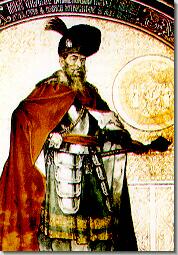Mihai Viteazul
|
|
Michael the Brave (Mihai Viteazul) was one of the greatest of Romania's national heroes. He was the Prince of Wallachia (1593–1601), of Transylvania (1599-1600), and of Moldavia (1600), thereby uniting for the first time the three Romanian principalities under one rule.
Mihai_viteazul.png
Michael became the Ban of Mehedinţi in 1588, the stolnic, or commissioner, at the court of Mihnea Turcitul by the end of 1588, and the Ban of Craiova in 1593 during the time Wallachia was ruled by Alexandru cel Rău (Alexander the Evil). In September 1593 with the help of the Ottoman Turks, he became the Voivod of Wallachia, starting his effective rule on October 11.
It was not long before he began to fight back against the Ottomans. The next year he adhered to a Christian alliance against the Turks and signed treaties with Sigismund Bathory of Transylvania and Aron Vodă of Moldavia. He started a campaign against the Turks in the autumn of 1594, conquering several citadels near the Danube, including Giurgiu, Brăila, Hârşova, and Silistra.
In 1595, at Alba Iulia, Michael signed a treaty with Sigismund Bathory in which Wallachia became a dependency of Transylvania, requiring it to send aid to fight the Turks.
On August 13 1595, at the Battle of Calugareni near the Neajlov river, Michael defeated a Turkish army led by Sinan Pasha, then continued by liberating Târgovişte, Bucharest and Brăila.
The fight against the Turks continued in 1596, when Michael made several incursions south of the Danube: at Vidin, Pleven, Nicopolis, Turnu and Babadag.
On October 18, 1599, he obtained an important victory in the Battle of Şelimbăr against Cardinal Andrew Bathory, gaining control of Transylvania. Michael entered stately Alba Iulia (Gyulafehérvár) with impressive pomp, receiving the keys to the fortress from the bishop Napragy.
When on May 8, 1600, Michael's forces defeated the combined Polish and Moldavian army of Ieremia Movilă at Bacău, the Romanian principalities were for the first time unified under one ruler.
However, neighboring states were alarmed by this upsetting of the balance of power, especially the Hungarian nobility from Transylvania who rose against Michael in rebellion. With the help of the Austrian general Giorgio Basta, they defeated Michael at the Battle of Miraslau, forcing Michael to leave Transylvania. A Polish army led by Jan Zamoyski drove the Wallachians from Moldavia, and defeated Michael at Naieni, Ceptura, and Bucov. The Polish army also entered eastern Wallachia and established Simion Movila as the ruler. Forces loyal to Michael remained only in Oltenia.
Desperate to find help, Michael asked for assistance from Rudolf II, the reigning Holy Roman Emperor and King of Hungary. However, he received help only when the emperor heard that Basta had lost control of Transylvania to the Hungarian nobleman lead by Sigismund Bathory. Meanwhile, forces loyal to Michael in Wallachia, after a first unsuccessful attempt, drove out Simion Movila and prepared to reenter Transylvania. Michael, allied with Basta, defeated the Hungarian noblemen at Gurăslău (Goroszló). However, this union did not last; Basta treacherously ordered the assassination of Michael in Câmpia Turzii, on 9 August 1601.
In essence, his legacy is that of being the first Romanian ruler to unite all the principalities in the Romanian space, albeit for only a short period of time. Many Romanian Unionists in the 1800s, made refference to his efforts in order to mobilize Romanians to unite once again in one country.
See also
| Preceded by: Alexandru cel Rău | Prince of Wallachia 1593-1601 | Succeeded by: Radu Mihnea |

